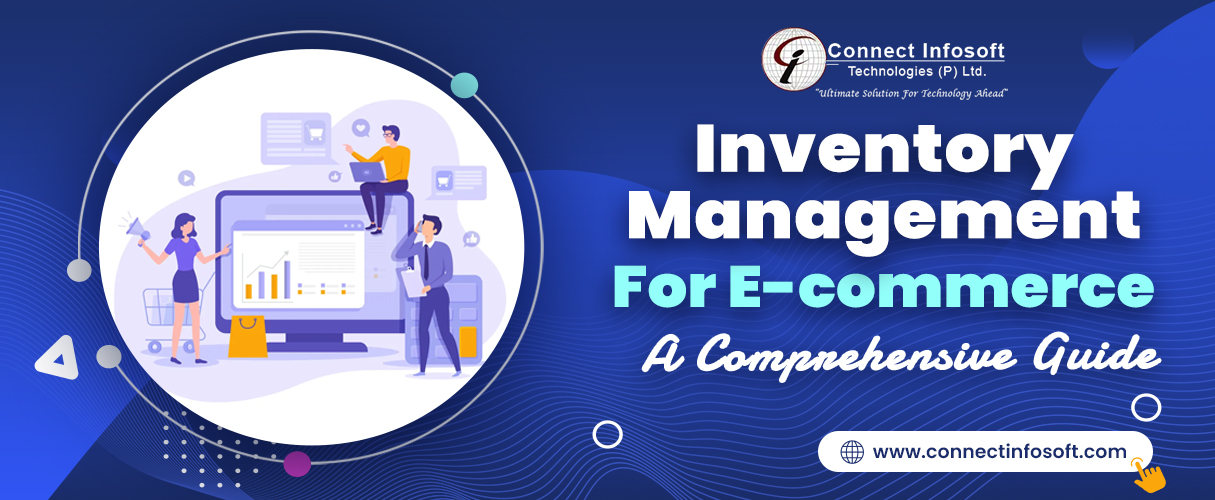Inventory Management for E-commerce: A Comprehensive Guide

In the ever-growing world of e-commerce, efficient inventory management is crucial for the success and profitability of online businesses. A well-executed inventory management strategy ensures that you have the right products in stock, minimizes storage costs, prevents stock outs, and ultimately enhances customer satisfaction. In this comprehensive guide, we will delve into the intricacies of inventory management for e-commerce, providing you with valuable insights and practical tips to optimize your inventory management processes.
Table of Contents:
1. Importance of Inventory Management in E-commerce
2. Types of Inventory for E-commerce Businesses
a. Raw Materials
b. Work-in-Progress (WIP)
c. Finished Goods
3. Key Inventory Management Techniques for E-commerce
a. ABC Analysis
b. Just-in-Time (JIT)
c. Dropshipping
d. Backorder Management
4. Implementing an Effective Inventory Management System
a. Choosing the Right Inventory Management Software
b. Setting Up Product Classification and Coding
c. Establishing Reorder Points and Safety Stock Levels
d. Implementing Cycle Counting and Physical Inventory Audits
5. Demand Forecasting and Inventory Optimization
a. Analyzing Historical Sales Data
b. Utilizing Demand Forecasting Tools
c. Collaborating with Suppliers and Sales Teams
6. Inventory Tracking and Real-time Visibility
a. Barcoding and RFID Technology
b. Integrated Systems and Automation
c. Cloud-based Inventory Management Solutions
7. Warehouse Management and Fulfillment
a. Efficient Warehouse Layout and Organization
b. Pick, Pack, and Ship Processes
c. Returns and Reverse Logistics
8. Inventory Cost Management and Financial Considerations
a. Carrying Costs and Holding Costs
b. Economic Order Quantity (EOQ)
c. Gross Margin Return on Investment (GMROI)
9. Inventory Analysis and Performance Metrics
a. Stock Turnover Rate
b. Fill Rate and Backorder Rate
c. Order Accuracy and Order Cycle Time
10. Continuous Improvement and Adaptation
a. Monitor and Adjust Inventory Policies
b. Embrace Technology Advancements
c. Stay Agile in a Changing Marketplace
1. Importance of Inventory Management in E-commerce
Inventory management plays a pivotal role in the success and growth of e-commerce businesses. In the fast-paced world of online retail, where customer expectations are high and competition is fierce, efficient inventory management is vital. Let's explore the key reasons why inventory management holds such significance in the realm of e-commerce.
- Optimized Stock Levels: Maintaining the right balance of inventory is crucial. Overstocking can tie up valuable capital, lead to increased storage costs, and risk product obsolescence.
- Customer Satisfaction: In e-commerce, customer satisfaction is paramount. Timely order fulfilment, accurate product availability, and fast shipping all contribute to a positive customer experience. Inventory management enables you to fulfil customer orders promptly and accurately, reducing the chances of backorders or delays. When customers receive their orders on time and as expected, their satisfaction increases, leading to repeat purchases and positive reviews.
- Demand Forecasting and Planning: Understanding customer demand patterns and forecasting future demand is essential for e-commerce success. By analysing historical sales data, customer behaviour, and market trends, you can make informed decisions about inventory replenishment, new product introductions, and seasonality. Effective inventory management allows you to anticipate demand fluctuations, plan inventory levels accordingly, and minimize stock outs or overstocks.
- Cost Control and Efficiency: Inventory represents a significant investment for e-commerce businesses. Efficient inventory management helps control costs and improve overall operational efficiency. By reducing excess stock, minimizing carrying costs, and optimizing order fulfilments processes, you can streamline operations and increase profitability. Additionally, accurate inventory tracking and real-time visibility enable you to identify and address issues such as shrinkage, stock discrepancies, and order inaccuracies.
- Effective Supply Chain Management: Inventory management is intrinsically linked to the broader supply chain. From suppliers to fulfillment centres to customers, a well-managed inventory ensures smooth operations across the entire supply chain. By establishing strong relationships with suppliers, implementing just-in-time (JIT) inventory practices, and optimizing order fulfillment processes, you can enhance supply chain efficiency, reduce lead times, and improve overall responsiveness.
- Adaptability and Scalability: E-commerce businesses often face rapid changes in demand, seasonal fluctuations, and growth opportunities. Effective inventory management allows you to adapt to these changes and scale your operations accordingly. By monitoring inventory levels, analyzing sales data, and collaborating with suppliers, you can quickly adjust your inventory strategy to meet changing market demands, introduce new products, and expand into new markets.
- Data-Driven Decision Making: Inventory management generates a wealth of data that can be leveraged for strategic decision making. By analyzing inventory performance metrics, such as stock turnover rate, fill rate, and order accuracy, you can gain valuable insights into your business's overall health and identify areas for improvement. This data-driven approach empowers you to make informed decisions, optimize inventory levels, and allocate resources effectively.
2. Types of Inventory for E-commerce Businesses
E-commerce businesses deal with various types of inventory throughout their supply chains. Understanding these different types is crucial for effective inventory management.
Here are the three primary types of inventory typically encountered in e-commerce:
- Raw Materials: Raw materials refer to the basic components or resources used to manufacture or assemble products. In the context of e-commerce, raw materials may include items such as fabrics, metals, plastics, or electronic components. E-commerce businesses that engage in product manufacturing or customization often need to manage raw material inventory to ensure a smooth production process and timely fulfillment of customer orders.
- Work-in-Progress (WIP): Work-in-progress inventory includes products that are in the process of being manufactured, assembled, or customized. This inventory represents partially completed products at various stages of production.
- Finished Goods: Finished goods inventory consists of fully completed products ready for sale and shipment to customers. These are the end products that e-commerce businesses offer on their websites or marketplaces. Managing finished goods inventory involves maintaining adequate stock levels to meet customer demand, avoiding stock outs, and preventing excessive inventory that ties up capital.
3. Key Inventory Management Techniques for E-commerce
To effectively manage inventory, e-commerce businesses employ various inventory management techniques based on their specific needs and goals.
a. ABC Analysis:
ABC analysis categorizes inventory items according to their value and relevance. The technique divides inventory into three categories: A, B, and C. Category A represents high-value items with a significant impact on revenue, category B includes moderately valuable items, and category C comprises low-value items.
b. Just-in-Time (JIT):
Just-in-Time inventory management aims to minimize inventory holding costs by receiving and producing goods only when needed. This approach relies on close coordination with suppliers to ensure timely delivery of materials or finished goods.
c. Dropshipping:
Dropshipping is an inventory management technique where e-commerce businesses partner with suppliers or manufacturers who handle the storage, packaging, and shipping of products directly to customers.
d. Backorder Management:
Backorders occur when customer orders cannot be fulfilled immediately due to insufficient stock. Backorder management involves tracking and fulfilling these orders as soon as inventory becomes available. It requires effective communication with customers, clear visibility into incoming inventory, and proactive inventory replenishment strategies.
4. Implementing an Effective Inventory Management System
Implementing an effective inventory management system is critical for guaranteeing smooth operations and increasing profitability in e-commerce enterprises.
a. Choosing the Right Inventory Management Software:
Investing in the right inventory management software is essential for streamlining processes, gaining real-time visibility into inventory, and optimizing stock levels. Evaluate various software options based on your business requirements, scalability, integration capabilities with other systems, user-friendliness, reporting capabilities, and cost.
b. Setting Up Product Classification and Coding:
Organizing products through proper classification and coding is essential for efficient inventory management. Establish a consistent and logical system for categorizing products based on attributes such as product type, brand, size, and variations. Assign unique codes or SKUs (Stock Keeping Units) to each product to ensure accurate tracking and easy identification.
c. Establishing Reorder Points and Safety Stock Levels:
Determining reorder points and safety stock levels is crucial to avoid stockouts and ensure uninterrupted order fulfillment. Reorder points indicate the inventory level at which a new order should be placed to replenish stock. Safety stock refers to the additional inventory kept as a buffer to account for unexpected fluctuations in demand or supplier delays.
d. Implementing Cycle Counting and Physical Inventory Audits:
Regular cycle counting and physical inventory audits are essential for maintaining accurate inventory records and identifying discrepancies. Cycle counting involves counting a subset of inventory items on a continuous basis, rather than conducting a full physical inventory count. This approach allows for ongoing error detection and correction. Periodic physical inventory audits involve physically counting all inventory items to reconcile with the recorded quantities.
5. Demand Forecasting and Inventory Optimization
To optimize inventory management, it is crucial to forecast demand accurately and align inventory levels accordingly.
a. Analysing Historical Sales Data:
Examine historical sales data to identify patterns, trends, and seasonality in customer demand. Analyze sales by product, category, customer segment, and time period to detect demand fluctuations and make informed inventory decisions.
b. Utilizing Demand Forecasting Tools:
Leverage demand forecasting tools and techniques to make data-driven predictions about future demand. Advanced algorithms, statistical models, and machine learning can help forecast demand based on historical data, market trends, promotions, and external factors.
c. Collaborating with Suppliers and Sales Teams:
Effective collaboration with suppliers and sales teams is vital for demand forecasting and inventory optimization. Share sales data, market insights, and upcoming promotions with suppliers to ensure they can meet demand requirements promptly. Maintain open lines of communication with the sales team to gather customer feedback, monitor market trends, and align inventory levels with anticipated sales.
6. Inventory Tracking and Real-time Visibility
a. Barcoding and RFID Technology:
Barcoding and RFID (Radio Frequency Identification) technology are essential tools for accurate inventory tracking and real-time visibility. Barcodes are unique identifiers attached to products, while RFID tags use radio waves to transmit data. By scanning barcodes or RFID tags, businesses can quickly record inventory movements, update stock levels, and track individual items throughout the supply chain.
b. Integrated Systems and Automation:
Integrating inventory tracking systems with other business systems, such as point-of-sale (POS) systems and order management platforms, enhances efficiency and accuracy.
Automated data exchange eliminates manual data entry, reducing errors and streamlining processes. Integrated systems provide real-time updates on sales, order fulfillment, and inventory levels, enabling businesses to make informed decisions and respond quickly to changes. Automation of inventory tracking processes improves operational efficiency and facilitates real-time visibility into inventory data.
c. Cloud-based Inventory Management Solutions:
Cloud-based inventory management solutions offer significant advantages for tracking inventory and gaining real-time visibility. These solutions store inventory data in the cloud, accessible from anywhere with an internet connection. They provide real-time updates on inventory levels, sales, and order fulfillment across multiple channels. Cloud-based solutions also allow for collaboration with suppliers, sales teams, and other stakeholders, fostering effective inventory management.
7. Warehouse Management and Fulfillment
a. Efficient Warehouse Layout and Organization:
An efficient warehouse layout and organization system are crucial for streamlined operations and effective inventory management. Optimize the warehouse layout to minimize travel time, improve picking efficiency, and reduce errors.
b. Pick, Pack, and Ship Processes:
Efficient pick, pack, and ship processes are key to timely and accurate order fulfillment. Implement strategies such as batch picking, where multiple orders are picked simultaneously, and zone picking, where different areas of the warehouse are assigned to specific pickers.
c. Returns and Reverse Logistics:
Returns and reverse logistics play a critical role in warehouse management and fulfillment. Establish clear procedures for handling returns and streamline the reverse logistics process. Implement a designated area for returned items, ensuring they are inspected, categorized, and processed efficiently.
8. Inventory Cost Management and Financial Considerations
a. Carrying Costs and Holding Costs:
Carrying costs and holding costs are financial considerations associated with holding inventory. Carrying costs include expenses such as warehousing, storage, insurance, depreciation, and obsolescence. These costs accumulate over time as inventory is held in the warehouse. Holding costs are the expenses incurred to maintain inventory levels, which include costs related to ordering, receiving, and managing inventory.
b. Economic Order Quantity (EOQ):
Economic Order Quantity (EOQ) is a formula-based approach to determine the optimal order quantity that minimizes inventory costs. It considers factors such as carrying costs, ordering costs, and demand rate. EOQ aims to strike a balance between the costs associated with holding excess inventory and the costs incurred through frequent ordering.
c. Gross Margin Return on Investment (GMROI):
Gross Margin Return on Investment (GMROI) is a financial metric that evaluates the profitability of inventory investments. It measures the return generated from each dollar invested in inventory. GMROI takes into account the gross margin (sales minus cost of goods sold) and the average inventory investment. A higher GMROI indicates better profitability and efficient use of inventory.
9. Inventory Analysis and Performance Metrics
a. Stock Turnover Rate:
Stock turnover rate, also known as inventory turnover, measures how quickly inventory is sold and replenished within a specific time period. It is determined by dividing the cost of items sold by the average inventory value. A high stock turnover rate suggests efficient inventory management, as products are sold quickly, reducing the risk of holding excess stock.
b. Fill Rate and Backorder Rate:
Fill rate measures the percentage of customer orders that can be fulfilled from available inventory without backorders. A high fill rate indicates good inventory availability and customer satisfaction. Backorder rate, on the other hand, calculates the percentage of client orders that cannot be fulfilled right away owing to stock outs.
c. Order Accuracy and Order Cycle Time:
Order accuracy measures the percentage of orders that are fulfilled correctly without errors or discrepancies. High order accuracy reflects strong inventory control, efficient picking and packing processes, and accurate order management systems.
10. Continuous Improvement and Adaptation
a. Monitor and Adjust Inventory Policies:
Continuous improvement in inventory management involves regularly monitoring and evaluating inventory policies, processes, and performance. This includes reviewing key metrics such as stock levels, turnover rates, fill rates, and order accuracy.
b. Embrace Technology Advancements:
Embracing technology advancements is essential for staying competitive and continuously improving inventory management. Businesses should leverage inventory management software, automation tools, data analytics, and artificial intelligence to enhance efficiency and accuracy. Advanced technologies like machine learning can help optimize demand forecasting, identify trends, and automate decision-making processes.
c. Stay Agile in a Changing Marketplace:
The marketplace is constantly evolving, and businesses must remain agile to adapt to changing customer preferences, market trends, and competitive landscapes. It's crucial to monitor industry developments, emerging technologies, and customer feedback to anticipate shifts in demand and adjust inventory strategies accordingly.
Conclusion:
Effective inventory management is the backbone of any successful e-commerce business. By implementing robust inventory management practices, you can optimize your operations, reduce costs, and provide a seamless experience to your customers. This comprehensive guide has provided you with a deep understanding of the various aspects of inventory management, from demand forecasting and tracking to warehouse management and financial considerations. Remember, inventory management is an ongoing process that requires continuous monitoring, analysis, and adaptation to keep up with the dynamic nature of the e-commerce industry. By prioritizing efficient inventory management, you position your e-commerce business for growth and long-term success.


